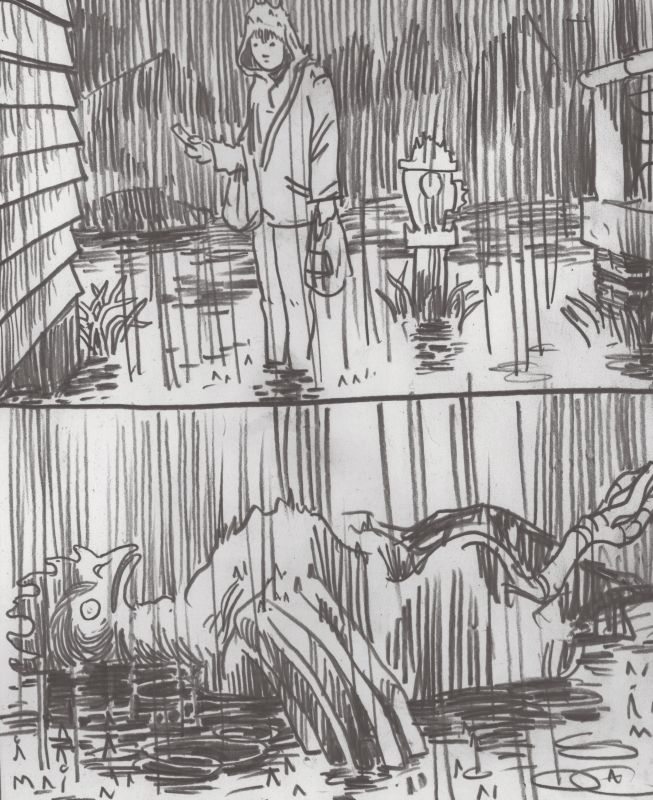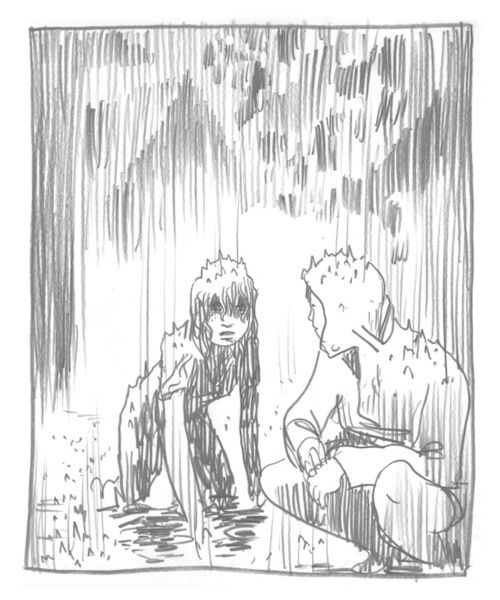The Open
The Feature
I hesitate writing this one. Not because of differing opinion, clashing the overall positive response to this work, but of the number of reviews already typed. Google "Sam Alden Backyard," and a collection of thought-pieces bubble up, some supplied by our circle's most-trusted judgers of taste. The sight of such response sensibly suggests to this budding essayist "no more are needed." The work was consumed and paraphrased, already, and by our most-informed minds, mind you. Even Sam Alden is miles beyond this book, preparing new work for next weekend's Comic Arts Brooklyn showcase. So I should go cover something different, new, obscurer, and play a role. The world needs new comics to poke at, not the same old shit.
But, really, it's short sighted to place a topic in such brief period of relevance, especially when it's art. We complain too often of our journalists for feeding the ever-active news cycle, spending too little time on a subject before jumping to the next news peg. Out of such speed we gain bullet points packed with generalized factoids rather than any sense of true insight, so it seems odd, in our world, that a comic should only stand review-able at a certain period of time. The work isn't exactly locked to any particular moment, so I should subdue my anxieties. Type this fucker up. Move on.
And that's just the plan I have.
Most reviews of this book hone in on its pacing and for good reason. The factor lends this title its mechanism unto which its spirit manifests. Without it, the clicking bite pronounced through each scene transition wouldn't exist, and the knock of each banal, daily activity filed by Alden's protagonist would miss its building repetition, flattening a key component of the story's theme. But beyond that, Alden's attention to structure and plot speaks for his concern of story, and through that Backyard gains the ability of transcendence via a timelessness appeal - a "literary" quality, if you will.
"The kind of comics that I like to make are accessible storytelling-based literature," Alden said in a recent Tumblr post.
His interests lie with the resolution of plot and separation of narrative between reader and character.
"In every story there’s the narrative of the characters within the story, and then there’s the narrative of the reader’s perception, if that makes any sense," Alden wrote. "Like the little emotional and intellectual journey that you take the reader on. And that second one is the important narrative to resolve."
So we understand his interest in the script, and, while again I'm not entirely super concerned with story these days, I find Alden's interest in it actually refreshing, especially when placed in the context of the above quote. But the element of Backyard I find most investing is the author's choice of visual texture (which, I know, sounds very fucking pretentious, but go with it, old timers). Scouting the image embedded above, you see Alden's bare-bones choice of pure pencil with maybe some charcoal blending, and while it's possible to relate his choice to some sort of trend of digital withdraw - a return to basics certainly alive in Frank Santoro's Pompeii - I'd link the aesthetic to a story device, instead.
So to explain this thing, plot wise ...
A group of friends live together, commune-style. One friend, Molly, begins to exhibit dog-like qualities - barking, crawling on all fours and living outside in the backyard (hence title). Other friends notice the change, show minimal concern, yet continue their self-absorbed existences presumably until something horrific happens (which it does).
Interpret the events how you will, but there's certainly an element of Alden's story working through the notion of failing to act, even when the choice should be clear. That's our thematic through line, so to speak, and Alden gives it visual definition by way of his black and white pencil depiction. You could view the sharp contrast between dark lines and clean paper as the stark divide between saying yes or no - Yes, we friends will aid our companion Molly, the barking backyard refugee, or, No, we will ignore her and run further with our own lives. The choice is black or white, conveyed eloquently by the lines pressed on the pages,but the images themselves aren't always so defined. At times, a muddiness blurs the line between the cartoonist's drawings and the paper beneath them, turning some details grey, hazy or sideways. The impurities of the artwork speak for that of the characters and their failure to intervene. It's like Alden built the narrative's conflict directly into the DNA of Backyard.
The final sequence, coated by a thick layer of rain (which you can see in the image above or below), really captures this tone, drudging all tension to a point at which it's no longer hidden. This of course works well for the scene, especially accenting Backyard's concluding page - a real stinger of an image.
If anything this approach speaks toward, other than Backyard's thematic ploy, is Alden's interest in "the narrative of the reader’s perception" versus the in-story perception of his characters. While we, thanks to the contrast of art and page, see sharply what's at stake, the cast of commune buddies does not. They do not possess the benefit of our viewpoint which is shaded by the author's hand. Instead, their eyes probably see color as well as a pacing similar to our everyday lives, trapping them in the moments they inhabit. We - distant of the plot - hold a vantage point at which the cartoonist, Sam Alden, feeds us the perception necessary for the mechanics of his story.
The Exit
TL;DR: This is fucking good. OMG, that last page.
You can purchase Backyard here.
Alec Berry fears cats. Follow him on Twitter @Alec_Berry.



